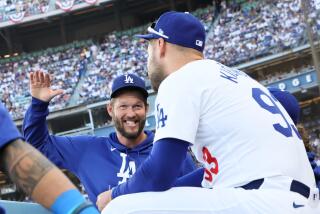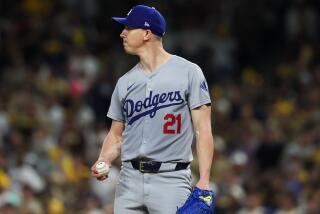Baseball ’90 PREVIEW : Arm Injury Forced Ex-Dodger Hough To Knuckle Down
It isn’t found in a manual or instructional guide, but calluses and courage are prerequisites for the knuckleball pitcher.
In the case of Charlie Hough, the hardened skin is on the tip of the index and middle finger of his right hand, which are dug into the ball, forming the basis of the knuckler grip.
The courage is on display each time Hough takes the mound.
“You want scared? You want to see how your nerves hold up? Stand 60 feet from Dave Winfield and float the ball up there at 60 miles per hour,” Hough says, sitting at his locker at the Texas Rangers spring training camp.
“Pretty ridiculous when you think about it.”
Ridiculous. Baffling. Tantalizing. Frustrating--sometimes for the pitcher as well as the hitter. Or the catcher.
A pitch learned--as it is in many instances--out of the desperation of a sore arm, it has enabled ex-Dodger Hough to survive for 18 major league seasons.
Survive and prosper, of course.
At 42, he is guaranteed $1 million.
He has a career record of 174-157, and over the past eight years only Jack Morris of the Detroit Tigers has posted more major league victories. But only Hough, among all major league pitchers, has registered 10 or more victories in each of the eight seasons, working at least 228 or more innings in seven of them.
On the eve of the new season, Hough is baseball’s pre-eminent knuckleball pitcher. Only one other--Tom Candiotti of the Cleveland Indians--throws it with regularity.
“There’s just not that many dummies left,” Hough said.
Hoyt Wilhelm retired at 49, Wilbur Wood at 37, Phil and Joe Niekro at 48 and 44.
Why such a rare and endangered breed when the knuckler obviously contributes to longevity because of its comparative lack of stress on shoulder and elbow?
“It starts with the scouts,” Hough said. “They’re not looking for guys with bad arms and saying, ‘We can teach them the knuckleball.’ They’re looking for the biggest, hardest throwing guys and saying, ‘We can teach them how to pitch.’
“There are also fewer minor league teams now, which means the decisions have to be made sooner and the borderline pitcher doesn’t stay around as long.
“A guy with a great arm like Dave Stewart may keep marching out there. He finally clicked with his fourth club, but if Dave had been a knuckleballer he would have had a tough time getting that far. Guys like me have to win and keep winning. We’ve got to produce from the start.
“The other thing is that the knuckler may look easy but probably only 5% of those who try ever master the separate processes of learning how to throw it and how to pitch with it.
“There’s a fine art to throwing it so it doesn’t spin and a fine art to throwing it in the strike zone.”
Hough was 21 and a hard-throwing Dodger prospect when he injured his arm in the late ‘60s. Goldie Holt, a scout and instructor, suggested the knuckler. And at about the same time, Wilhelm, the Dutch master, joined the organization for his final two seasons.
“I could throw it right away but I didn’t know how to pitch with it and I followed Wilhelm around like a puppy dog,” Hough said.
“I mean, even at a thousand years old, playing catch with him was scary (because of the ball’s movement). I’m not sure anyone will ever throw it as well or will get the chance. He had the best pure knuckler I’ve ever seen, but I consider Phil Niekro the best pitcher and competitor with it.”
Hough used the maturing knuckler to save 40 games for the Dodgers in 1976 and ‘77, then experienced a siege of inconsistency, as all relief pitchers do, and became a target of fan abuse and infrequent employment.
He was sold at a clearance price to the Rangers in 1980 and eventually was made a starter, where he had more room for error and could use his modest fastball and slider as unexpected complements to the knuckler, and vice versa.
Hough now keeps an eye on the speed gun in the same way that teammate Nolan Ryan does, varying his arm speed to vary the speed of the now-you-see-it, now-you-don’t knuckler, which registers anywhere between 50 m.p.h. and the low 70s.
Last year, for the first time in his major league career, Hough went on the disabled list with an arm injury, a shoulder problem that was the result of trying to do too much too soon. Healthy again, he was asked if he can emulate mentor Wilhelm and make it to 49?
“Even if the arm lasted, I don’t think the legs will,” Hough said. “I couldn’t cover first base, couldn’t get to a bunt, couldn’t compete.”
An off-season resident of Brea, Hough’s blithe demeanor has helped him cope with those perilous moments when the knuckleball, which has given him so much, taketh away.
“But I’ve never stood on the mound in the ninth inning and said, ‘Damn, I hope this one doesn’t get away,’ ” Hough said. “I know that sometime during the year I figure to lose a game on a passed ball or a wild pitch or a walk or a stolen base.
“On the other hand, I never forget it’s the only reason I’m in the big leagues.”
More to Read
Go beyond the scoreboard
Get the latest on L.A.'s teams in the daily Sports Report newsletter.
You may occasionally receive promotional content from the Los Angeles Times.










